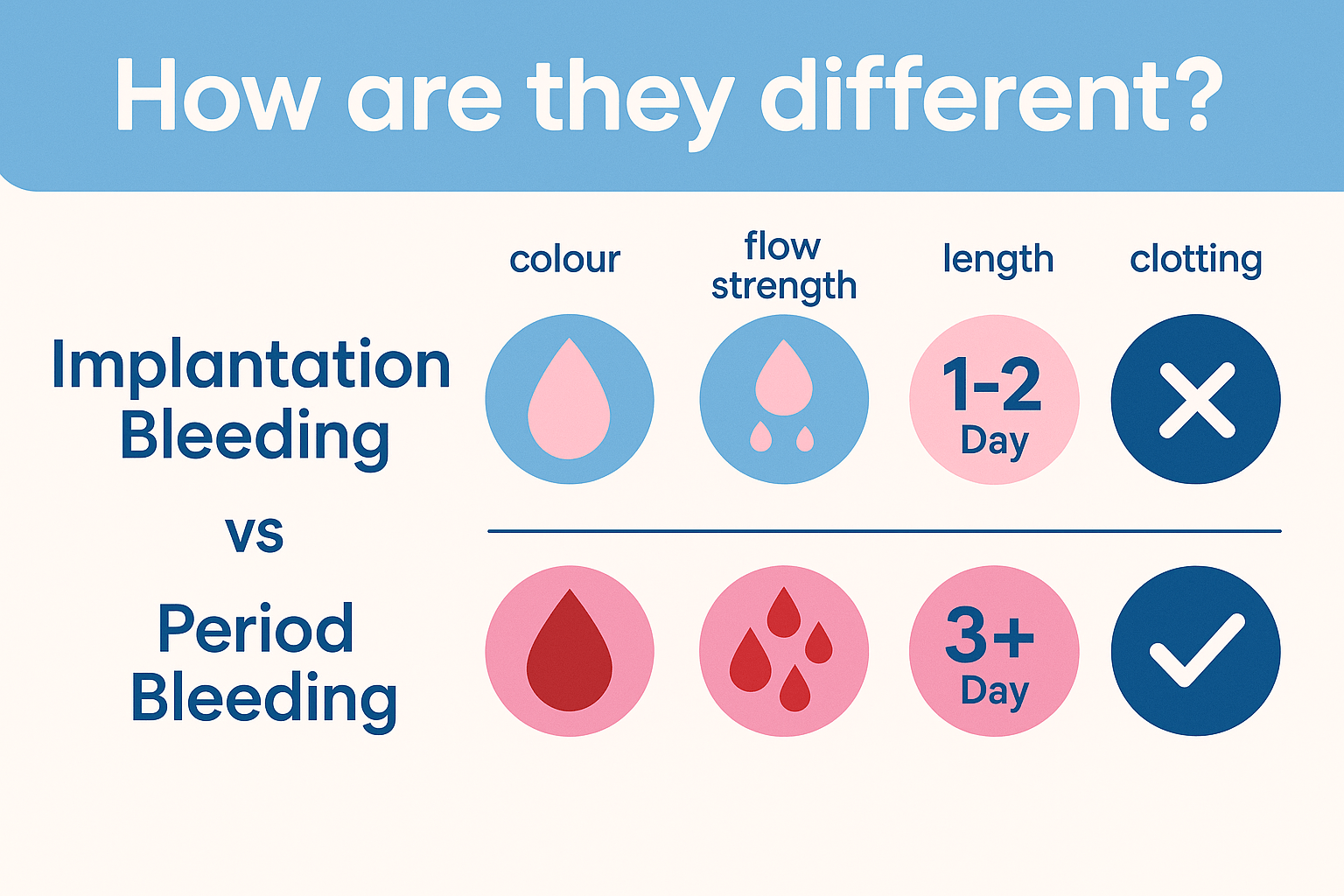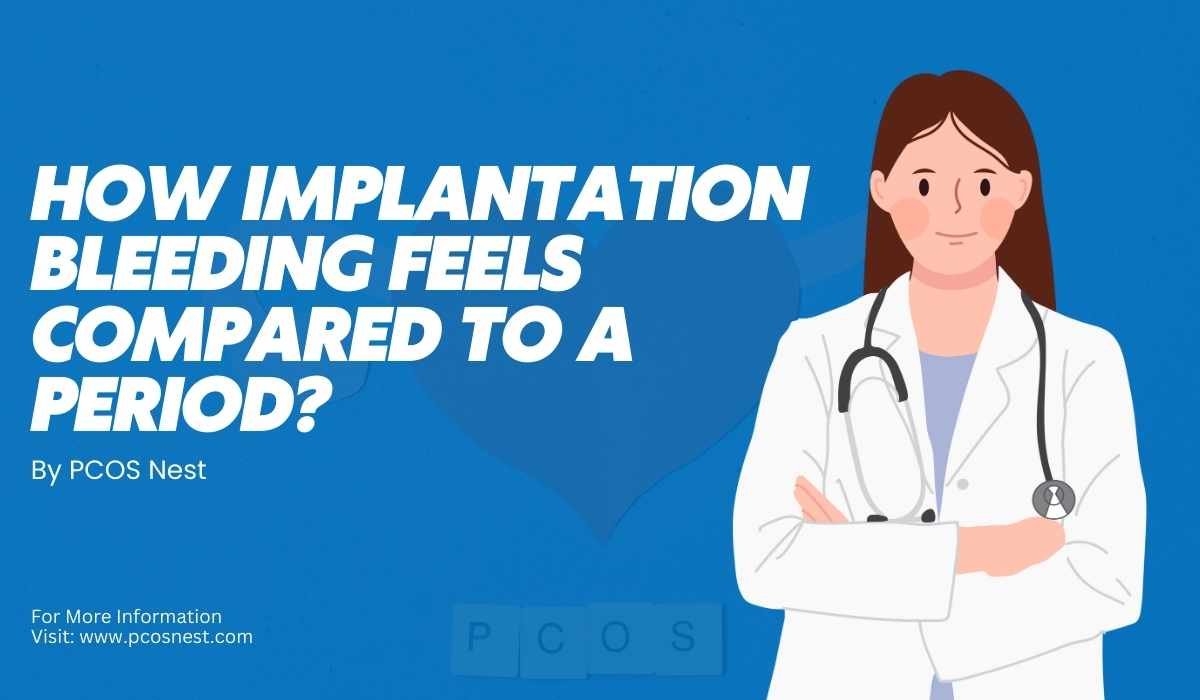What is Implantation Bleeding?
Implantation bleeding happens when a fertilized egg (the egg and sperm combined) travels down to the uterus and attaches itself to the uterine lining.
When the egg sticks itself into the lining, some tiny blood vessels can break, causing light bleeding or spotting.
It usually happens:
- Around 6 to 12 days after ovulation (the release of the egg).
- Just before or around the time you might expect your period.
How it looks:
- Very light bleeding (pinkish, brownish, or sometimes a little red).
- Lasts from a few hours to 2-3 days.
- No heavy flow — usually not enough to fill a pad or tampon.
It is normal and not a problem.
It is often one of the early signs of pregnancy.
Symptoms of Implantation Bleeding:
- Light spotting (not heavy like a period)
- Mild cramping (lighter than period cramps)
- No clots (unlike periods which sometimes have clots)
- No bad smell (normal spotting smell)
“Implantation bleeding is a common and harmless early pregnancy symptom caused by the embryo embedding itself into the uterine wall.”
— Clinical Methods: The History, Physical, and Laboratory Examinations (1990)

How Implantation Bleeding and PCOS are Related:
Now, let’s talk about PCOS (Polycystic Ovary Syndrome) and how it connects:
Women with PCOS often have irregular ovulation — meaning their eggs may release late, rarely, or not at all.
Because ovulation is not regular, it becomes hard to predict when or if implantation bleeding would happen.
Here are some important points:
1. Irregular Ovulation = Unpredictable Implantation
- In women with PCOS, ovulation can happen anytime — early, late, or sometimes not at all.
- If ovulation happens, pregnancy is possible, and implantation bleeding can occur.
- But because periods are irregular, women with PCOS might confuse implantation bleeding with just another random spotting.
“Women with PCOS may have difficulty recognizing implantation bleeding due to unpredictable cycles and hormonal spotting that can mimic early pregnancy symptoms.”
— Journal of Clinical Endocrinology & Metabolism (2017)
2. PCOS Spotting vs. Implantation Bleeding:
- PCOS spotting often happens because of hormone imbalance (especially low progesterone).
- Implantation bleeding happens because of pregnancy.
- Both may look similar (light spotting), but the timing and other pregnancy symptoms (like nausea, tiredness) can help tell the difference.
3. Hormone Imbalances Make It Tricky
- Women with PCOS often have higher androgens (male hormones) and low progesterone.
- These hormone problems can cause random bleeding, even if they are not pregnant.
- So, spotting alone cannot confirm pregnancy in PCOS women, a pregnancy test is needed to be sure.
“In PCOS, breakthrough bleeding is common due to unopposed estrogen exposure, making it challenging to distinguish from true implantation spotting.”
— Williams Textbook of Endocrinology (14th edition).
| Implantation Bleeding | PCOS Spotting |
| Happens if pregnancy starts | Happens anytime |
| Lasts 1-2 days | Can be random or for many days |
| Light, pink/brown color | Can be brown, pink, or bright red |
| Mild cramps or no cramps | May or may not have cramps |
| Happens about 6–12 days after ovulation | No specific timing |
| Pregnancy test becomes positive | Pregnancy test negative unless pregnant |
Final Important Points:
- If you have PCOS and notice light bleeding, don’t assume right away if it’s implantation or just spotting.
- Wait a few days and take a pregnancy test. Blood tests (hCG tests) are more accurate early on.
- Track ovulation (using ovulation strips or apps) if you are trying to get pregnant with PCOS, it can help predict implantation better.
“Because of an ovulation and irregular menses in PCOS, implantation bleeding can easily be misidentified without hormonal or ultrasound confirmation.”
— The Practice Committee of the American Society for Reproductive Medicine (ASRM, 2018)
Also Read: Effective & Easy Herbal Treatment for Irregular Periods
Frequently Asked Questions:
How do I know if it’s implantation bleeding?
Doctors suggest that if bleeding is heavy, lasts longer, or has clots, it’s likely not implantation. You might be having implantation bleeding if the spotting is very light, showing colors like pink, brown, or very light red. It usually happens about 6 to 12 days after ovulation, around the time you would expect your period. You may experience mild cramps or no cramps at all.
Can we test pregnancy during implantation bleeding?
You can take a pregnancy test during implantation bleeding, but it’s often too early for accurate results.
How long after implantation bleeding will I test positive?
You can usually test positive about 3 to 5 days after implantation bleeding. This is because it takes time for the pregnancy hormone (hCG) to build up to detectable levels. For the most accurate result, doctors recommend waiting at least one week after implantation bleeding to take a pregnancy test.
How soon after sex does implantation bleeding occur?
Implantation bleeding usually occurs 6 to 12 days after sex that leads to fertilization. This is the time it takes for the fertilized egg to travel to the uterus and attach to the uterine lining.
Conclusion:
In easy words:
- Implantation bleeding is a small sign that pregnancy might have started.
- In women with PCOS, it can be hard to recognize because PCOS itself causes random spotting.
- The only sure way to know is to take a pregnancy test or see a doctor.

